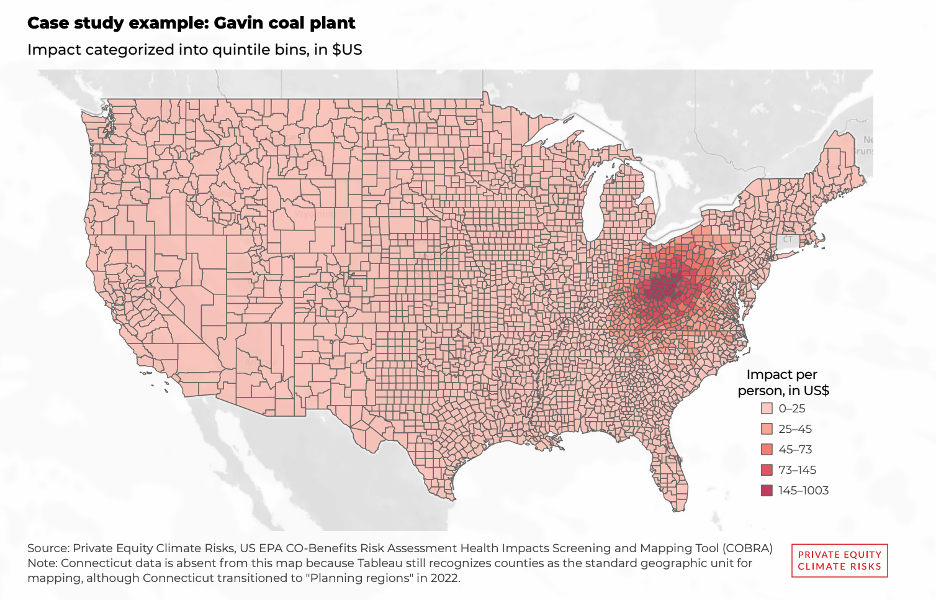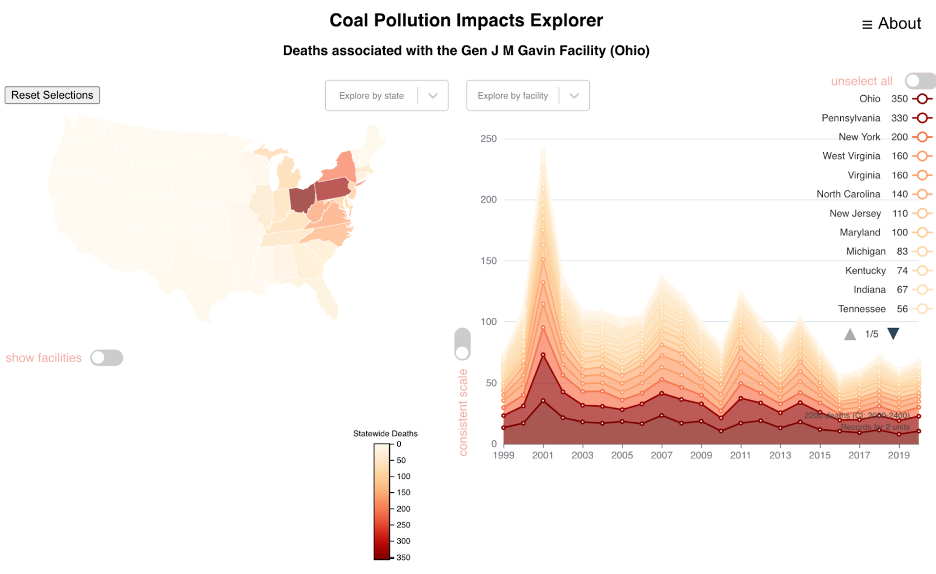
Public health costs of the Gavin coal-fired power plant
July 30, 2025
The recently-released Private Equity, Public Harm report, outlining the public health impacts caused by emitted air pollutants from private equity-backed fossil fuel infrastructure, found that the General J.M. Gavin coal-fired power plant is the single most harmful facility in the study. The plant is estimated to cause $1.7 billion in human health impacts per year. These human health impacts include heart attacks, hospital admissions, emergency room visits, asthma onset and symptoms, lung cancer, Alzheimer’s Disease, Parkinson’s Disease, strokes, hay fever, cardiac arrests, losses of school days, losses of work days, and deaths.

Graphic: Private Equity, Public Harm report
Gavin has been passed between private equity firms
On July 23, 2025,the Federal Energy Regulatory Commission approved the sale of the Gavin coal plant from Lightstone Generation LLC, a joint venture between the private equity firms Blackstone Group and ArcLight Capital Partners to a third private equity firm, Energy Capital Partners (ECP), which is owned by Bridgepoint Group.
From Ohio to New York, Gavin coal plant has a high public health cost
While a dollar amount will never capture the complexity of the human experience of facing health conditions brought about by pollution, using a standardized measure such as costs can be helpful in quantifying medical treatment, lost productivity, missed school days, and premature deaths.
The Gavin coal plant is the single biggest contributor to ECP’s health impacts. According to the report, emissions from ECP assets nationally are estimated to cause between $1.8 and $3.3 billion in costs related to health impacts] each year. The emissions are estimated to cause 62,000 asthma incidents, 130 emergency room visits, 11,000 lost work days, $15,000 lost school days, and over 200 premature deaths.
Ohio is the state most heavily impacted by ECP’s emissions, with between $350,000,000 and $640,000,000 in health costs per year. Pennsylvania is next, with ECP assets costing residents between $220,000,000 and $390,000,000 per year. Every state is affected by pollution from ECP’s assets.
Within Ohio, ECP’s pollution is estimated to cause 12,000 asthma incidents, 24 emergency room visits, 1,900 missed work days, 2,800 lost school days, and 43 premature deaths. The highest estimated impacts are in the most populous counties. Franklin, Cuyahoga, Summit, and Hamilton Counties have the highest health impacts in Ohio as the four most populous counties in the state.
In Pennsylvania, pollution from ECP’s assets are estimated to cause 6,300 asthma incidents, 14 emergency room visits, 1,000 missed work days, 1,700 lost school days, and 26 premature deaths. The highest costs of health impacts in Pennsylvania from ECP assets are a combination of populous counties – Allegheny and Philadelphia – and counties in the western part of the state – Westmoreland, Washington.
2023 analysis by the Sierra Club shows how the pollution plume extends to the Eastern Seaboard, carrying hazardous particulate matter through the air for hundreds of miles. According to the Sierra Club research, negative health impacts from the Gavin coal plant extend across the northeastern United States, from Illinois to New Jersey and New York to Florida.

Graphic: Sierra Club, Coal Pollution Impacts Explorer
Investors should push Gavin’s owners for a responsible retirement
Energy Capital Partners, the private equity firm seeking to purchase the Gavin coal plant, is owned by private equity firm Bridgepoint. In a September 2023 presentation, Bridgepoint described ECP as “a leading infrastructure fund focusing on electrification, decarbonization, and sustainability-focused investing”. The description of ECP as a “market-leader in electrification, decarbonization and sustainability-focused added value investing” is difficult to square with ECP’s promise in a FERC filing that “the Gavin facility (and the facilities owned by the other Lightstone Public Utilities) will continue to operate for so long as they are legally able to do so on an economic basis.”
Considering the enormous public health costs associated with Gavin, investors with the plant’s current owners – ArcLight and Blackstone – and those with the firm seeking to purchase the plant – Energy Capital Partners and its owner, Bridgepoint – should insist that the owners commit to a responsible retirement plan for the Gavin coal plant by 2028.
